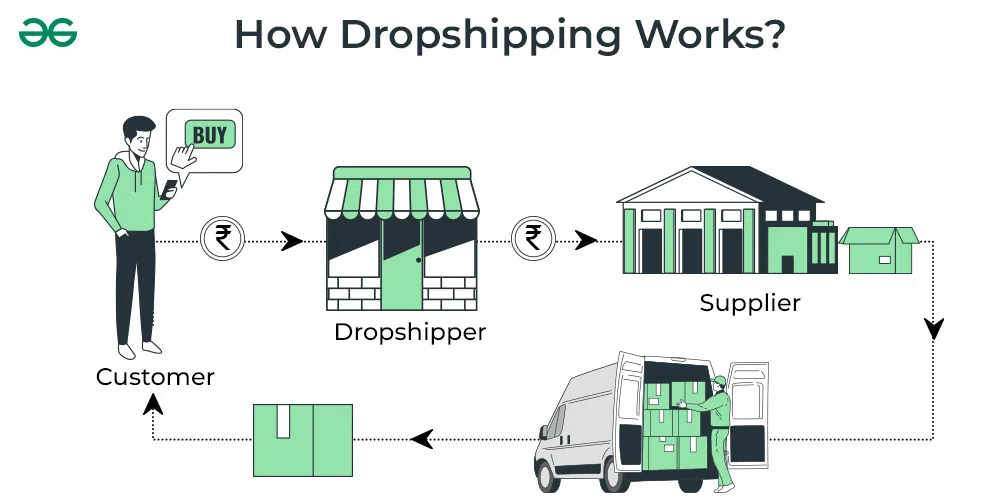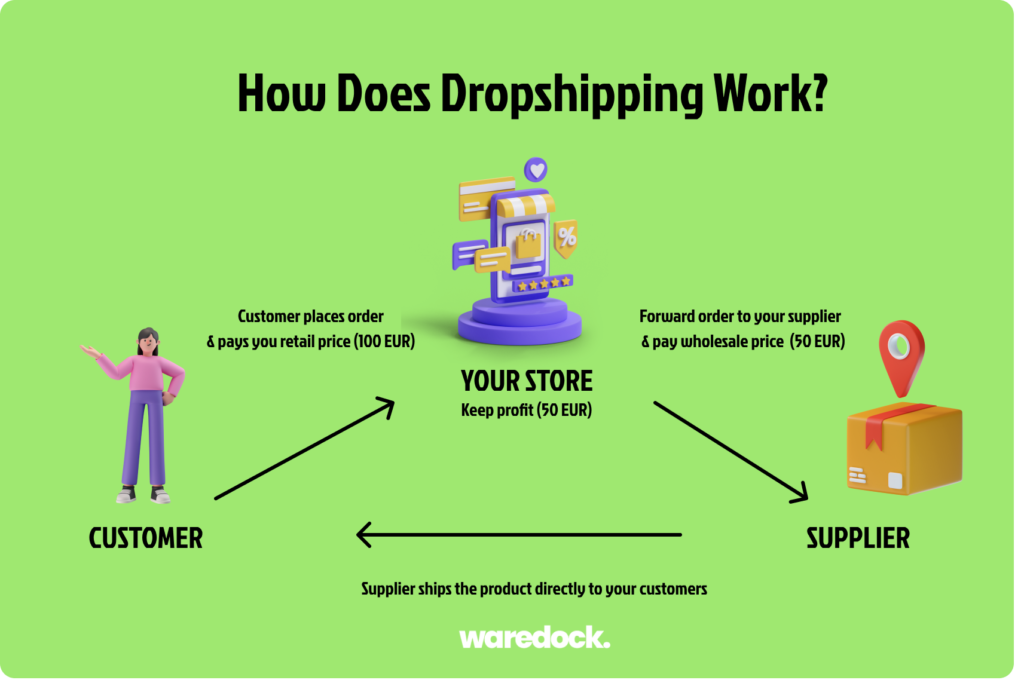Foods & Drink
What is Dropshipping And How Does It Work: A Complete Guide
Dropshipping is a retail fulfillment method where a store doesn’t keep the products it sells in stock. Instead, when a store sells a product using the dropshipping model, it purchases the item from a third party and has it shipped directly to the customer.
Table of Contents
This means the seller doesn’t have to handle the product directly. The main advantage of dropshipping is that it eliminates the need for inventory storage and shipping logistics, making it an attractive option for new entrepreneurs or businesses looking to expand their product offerings without the added hassle.
With the rise of e-commerce, dropshipping has become a popular and viable business model for many online retailers. We’ll explore the ins and outs of dropshipping and how it can work for your business.
The Rise Of Dropshipping
Dropshipping has become a popular business model in the world of e-commerce. It eliminates the need for a physical inventory, making it an attractive option for entrepreneurs. The rise of dropshipping can be traced back to the evolution of e-commerce. With advancements in technology, online shopping has become more convenient and accessible. Customers now expect fast and efficient service, which has led to the emergence of dropshipping as a viable solution.
Current trends in e-commerce also contribute to the popularity of dropshipping. The growth of social media and influencer marketing has created opportunities for entrepreneurs to promote their dropshipping businesses. Additionally, the increasing demand for niche products and personalized shopping experiences has fueled the success of dropshipping. As the e-commerce landscape continues to evolve, dropshipping is expected to remain a prominent business model.

Credit: www.geeksforgeeks.org
Dropshipping Explained
Dropshipping is a retail fulfillment method where a store doesn’t keep the products it sells in stock. Instead, when a store sells a product using the dropshipping model, it purchases the item from a third party and has it shipped directly to the customer. As a result, the seller doesn’t have to handle the product directly.
This business model is different from traditional retail because the seller doesn’t stock or own inventory. This means the seller doesn’t have to invest as much capital upfront. In traditional retail, the seller purchases inventory from a wholesaler or manufacturer, keeps it in stock, and then ships it to the customer. In dropshipping, the seller only purchases the product when it’s already been sold. This model has gained popularity due to its low barriers to entry and minimal capital requirements.
The Dropshipping Process
Dropshipping is a retail fulfillment method where a store doesn’t keep the products it sells in stock. Instead, when a store sells a product, it purchases the item from a third party and has it shipped directly to the customer. Here are the steps involved in the dropshipping process:
Choosing A Supplier
The first step is to find a supplier who offers dropshipping services. Look for suppliers who have a good reputation, offer a wide variety of products, and have reasonable prices. You can use online directories or search engines to find potential suppliers.
Listing Products Online
Once you have chosen a supplier, you need to list their products on your online store. Make sure that you create detailed product descriptions, include high-quality images, and set competitive prices. Use search engine optimization (SEO) techniques to make your products more visible to potential customers.
Order Fulfillment Cycle
When a customer places an order on your website, you need to forward the order details to your supplier. The supplier will then ship the product directly to the customer. You should provide your customers with tracking information so that they can monitor the progress of their orders. Make sure that you handle any customer service issues in a timely and professional manner.
| Advantages | Disadvantages |
|---|---|
| Low startup costs | Limited control over product quality and shipping times |
| No inventory management required | Thin profit margins |
| Flexible location | High competition |

Credit: www.waredock.com
Key Players In Dropshipping
Dropshipping is a retail fulfillment method where a store doesn’t keep the products it sells in stock. Instead, suppliers and manufacturers handle inventory and shipment. The merchant is responsible for marketing and customer acquisition. Shipping and logistics providers are crucial for ensuring timely delivery to customers. This method allows merchants to offer a wide range of products without investing in inventory. Suppliers and manufacturers take care of product storage, packaging, and shipping, allowing the merchant to focus on sales and marketing. Effective collaboration between these key players is essential for the success of a dropshipping business.
Starting A Dropshipping Business
Before starting a dropshipping business, it is important to conduct thorough market research to identify profitable niches and popular products. This helps in choosing the right suppliers and setting competitive prices.
Creating an online store is the next step. Choose a user-friendly platform with features like automated order processing, easy product management, and customizable templates.
Legal considerations include obtaining necessary permits and licenses, registering your business, and complying with tax laws. It is also important to have clear terms of service and refund policies to protect your business.
| Market Research | Creating Your Online Store | Legal Considerations |
|---|---|---|
| Identify profitable niches | Choose a user-friendly platform | Obtain necessary permits and licenses |
| Research popular products | Use customizable templates | Register your business |
| Select the right suppliers | Automate order processing | Comply with tax laws |
Pros And Cons Of Dropshipping
Advantages for Entrepreneurs:
- Low startup costs: With no need to manage inventory, dropshipping reduces the initial investment required to start a business.
- Flexible location: Dropshipping allows entrepreneurs to run their business from anywhere in the world as long as they have an internet connection.
- Wide selection of products: As dropshippers do not have to stock inventory, they can offer a wide range of products to their customers.
- Easy to scale: As the business grows, entrepreneurs can easily add more products to their online store without worrying about storage space.
Potential Challenges and Risks:
- Low-profit margins: As the cost of goods sold is higher in dropshipping, entrepreneurs may struggle to make a significant profit.
- Less control over shipping and handling: Dropshippers rely on their suppliers to deliver products, which can result in delays and errors.
- Increased competition: As dropshipping is a popular business model, entrepreneurs may face intense competition in their niche.
- Difficulties with customer service: As entrepreneurs do not handle products themselves, they may have difficulty resolving customer issues related to shipping or product quality.
Marketing Your Dropshipping Store
Dropshipping is a retail fulfillment method where a store doesn’t keep the products it sells in stock. Instead, when a store sells a product, it purchases the item from a third party and has it shipped directly to the customer. Effective SEO practices involve optimizing product descriptions and metadata, conducting keyword research, and building high-quality backlinks. Social media strategies can include creating engaging content, running targeted ads, and engaging with the audience. Email marketing and retargeting can help in building relationships with customers, offering personalized recommendations, and recovering abandoned carts.

Credit: www.netsuite.com
Scaling And Optimizing
Dropshipping is a business model where online retailers can sell products without actually having to stock inventory. Instead, the retailer purchases the products from a third-party supplier who then ships them directly to the customer. This allows for easy scaling and optimization of the business, as the retailer does not have to worry about inventory management or shipping logistics.
Dropshipping businesses have the potential to grow rapidly. Analyzing performance data is crucial to identify areas of improvement. It’s important to keep track of metrics such as conversion rates, traffic sources, and customer behavior. This data will help in making informed decisions about marketing strategies and product offerings.
Customer service excellence is vital to dropshipping success. Providing prompt, friendly, and helpful customer support can increase customer satisfaction and loyalty. It’s essential to respond to customer queries promptly and resolve any issues as soon as possible.
Expanding product offerings can help to attract new customers and increase sales. Researching and adding new products to the store can keep the store fresh and exciting for customers. It’s important to choose products that align with the store’s niche and customer base.
Future Of Dropshipping
Dropshipping is a business model where retailers don’t keep products in stock. Instead, they partner with a third-party supplier who fulfills orders directly to customers. This allows retailers to operate with minimal inventory and low upfront investment. The future of dropshipping is heavily influenced by technological advancements. With the rise of automation and AI, dropshippers can streamline order fulfillment and enhance customer experience. Predicting market shifts becomes easier with data analytics and machine learning. These advancements enable dropshippers to adapt to changing consumer behaviors and seize opportunities. As technology continues to evolve, the landscape of dropshipping will continue to transform, offering new efficiencies and innovative solutions for e-commerce businesses.
Frequently Asked Questions
How Does Dropshipping Make Money?
Dropshipping makes money by acting as a middleman between customers and suppliers. You set up an online store, market products, and when a customer makes a purchase, you forward the order to the supplier who ships it directly to the customer.
You earn profit from the difference between the wholesale and retail prices.
Is Dropshipping Actually Worth Doing?
Yes, dropshipping can be worth it. It allows you to sell products without inventory, reducing upfront costs. However, success depends on factors like product selection, marketing strategies, and customer service. Consider researching and planning before starting a dropshipping business to increase your chances of success.
Who Pays You In Dropshipping?
In dropshipping, customers pay you directly for the products. You then purchase the item from the supplier, keeping the profit.
How Much Money Does It Cost To Start Dropshipping?
The cost to start dropshipping varies but can be as low as $50 to $500. Factors include website, marketing, and inventory expenses.
Conclusion
Dropshipping is a business model that allows entrepreneurs to sell products without having to carry inventory. It offers a low-risk way to start an online business and can be a great option for those looking to enter the e-commerce world.
By understanding how dropshipping works and implementing effective strategies, entrepreneurs can build successful and profitable online stores. Embracing the potential of dropshipping can open up a world of opportunities for aspiring business owners.




















Pingback: Discover Effective Strategies for Promoting Your Dropshipping Store on Facebook